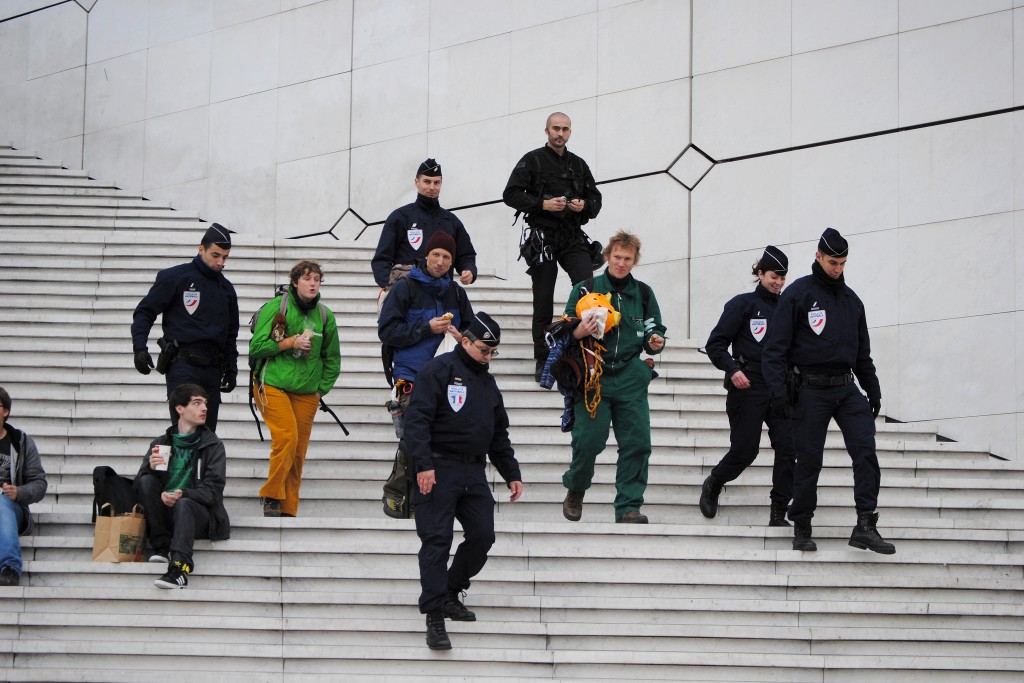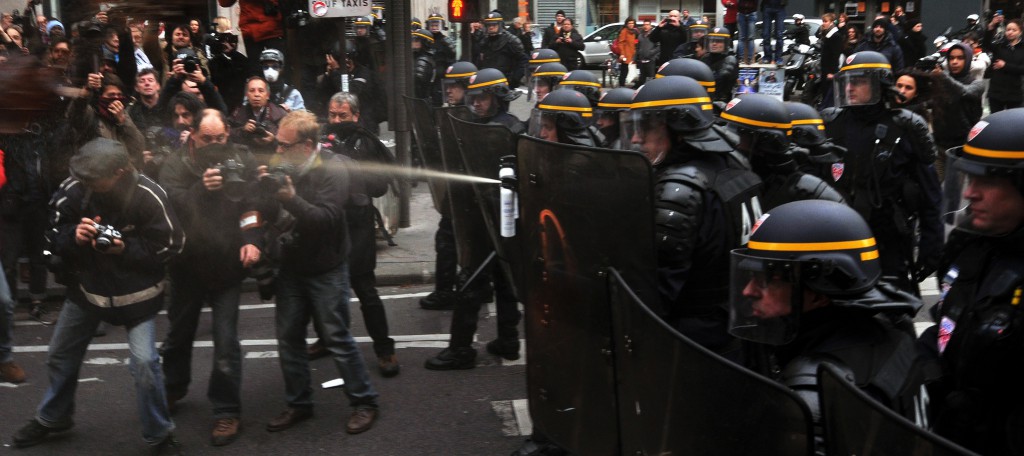
During the two years before COP21, a large group of French and international NGOs, unions, social movement organizations, and grassroots groups united in the Coaltion Climat 21 (and beyond) to develop and coordinate a range of actions to demand climate action and to act for climate justice. The result of this process was a call for action covering the two weeks of the COP.
These plans changed dramatically, however, after the attacks of November 13. While the climate change movement has long faced an uphill battle at COPs, since the terror attacks of November 13, its path has become extra steep.
Immediately after the attacks, it became clear that the mobilization would be strongly affected by this new situation – in particular by the ‘state of emergency’ that was installed in reaction to the terror threat. On the Wednesday after the attacks it was declared that all planned mass mobilizations during the first and last weekend of the COP were forbidden. The movement had about ten days to come up with new action plans.
How has the movement reacted to this situation?
On the Thursday after the bans were announced, organizers came together in Paris to start developing new ideas that would still allow them to voice their concerns about climate change. As certain groups in the coalition insisted on respecting the ban on demonstrations, the coalition decided to cancel the global climate march that was planned in Paris on November 29. The idea of the human chain was introduced to replace it: a chain of individuals standing next to each other on the sidewalk provided a means to show the movement’s message along the march’s original trajectory, while being likely to be tolerated by the police. But also the plans for civil disobedience actions had to be adjusted. Even though they were essentially illegal in the first place, organizers had to take into account a context with increased police repression, and the accommodating increased risks.

Yet the state of emergency not only affected the actions of the movement – it also changed its message in at least two ways. Firstly, soon after the attacks, many organizers realized that in order to pay tribute to the severity of the attacks, they needed to address the question of terror. They decided to do so by highlighting the interrelatedness of the climate struggle and questions of peace: climate change is already disrupting areas leading to conflict, and a future of climate chaos will only increase this situation. As such, the new situation, and the broadening of the movement’s topic could even bring unusual suspects into the movement. Secondly, not so much the attacks themselves, but in particular the state of emergency have brought in another new topic to the movement: that of civil liberties and the right to freedom of expression. Climate activists and civil liberty campaigners have found each other in a struggle to claim the right to express concerns, this time specifically about climate change.
Finally, the state of emergency affected organizers’ and activists’ perceived chances of success. While the situation may be a source of despair to some activists, others have pronounced that the repression they are facing is an indication that they are now considered a force to be reckoned with, and that they might even be winning. Director of Greenpeace International, Kumi Naidoo, used the words of Gandhi when he said “First they ignore you, then they laugh at you, then they fight you, and then you win. They are fighting us, so we must be winning.”
How does this change the field of action?
While there is still an important degree of optimism, in the streets, the climate movement is facing severe police repression whenever they try to cross any of the boundaries set by the state of emergency. In fact, the level of repression became already clear before the COP, and before any action even started. 24 activists, including a member of the movement’s legal team, were put under house arrest. Moreover, a number of squats where activists were staying to prepare actions were raided by dozens of policemen.

In the streets, the activists face high levels of protest policing. On November 29, thousands of protesters defied the government’s ban on protesting by gathering on the Place de la République at the time that the original march was planned. Their protest was met with enormous police presence. All eight exit streets off the square were blocked by riot police in order to prevent the activists from leaving the square and march, as some of them had planned to do. When the situation escalated, the activists could not leave the square and a large group of them was ‘kettled’ in one corner, after which about 300 of them were taken into custody.
Actions of a smaller scale have met equally strict policing. On Friday December 4, a group of activists planned to disrupt the opening of the ‘solutions COP21’, by giving ‘toxic tours’ to highlight ‘corporate greenwashing’ to the audience and the press. On the outside of the event, hundreds of riot cops were present to control the streets and access to the venue. Inside, dozens of plain clothes police were ready to intervene once the ‘toxic tours’ started. Both activists and journalists were dragged out of the building because they spoke up for what they considered to be wrong. The small protest that emerged as a result on the outside was soon dispersed by a police force that may have actually outnumbered the protesters.
The police is not everywhere
During the past weekend, Coaltion Climat 21 held the Citizens’ Climate Summit – one of the few actions that have not been banned by the government. It combined a peasants market, a ‘village of alternatives’, a climate forum with lectures, discussions and workshops, and even a parade – with more than two people, and a political message, thereby violating the ban on protesting (!). During this event, the police were hardly visible. For the first time in my life, I experienced how relaxing it can be when there is not a large continent of police at a protest who have their tear gas and pepper spray ready at all times.
During the second week of the COP, more actions are planned, some of which legal, other disobedient. Let me conclude by saying that I honestly hope that during these actions, climate activists will be allowed to voice their concerns in a more peaceful and dignified way. Given the severity of the climate crisis we are facing, their message deserve to be heard.